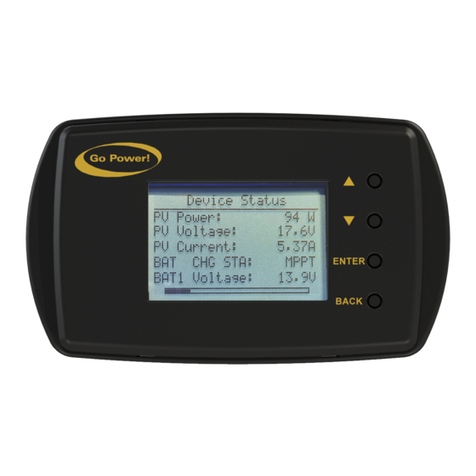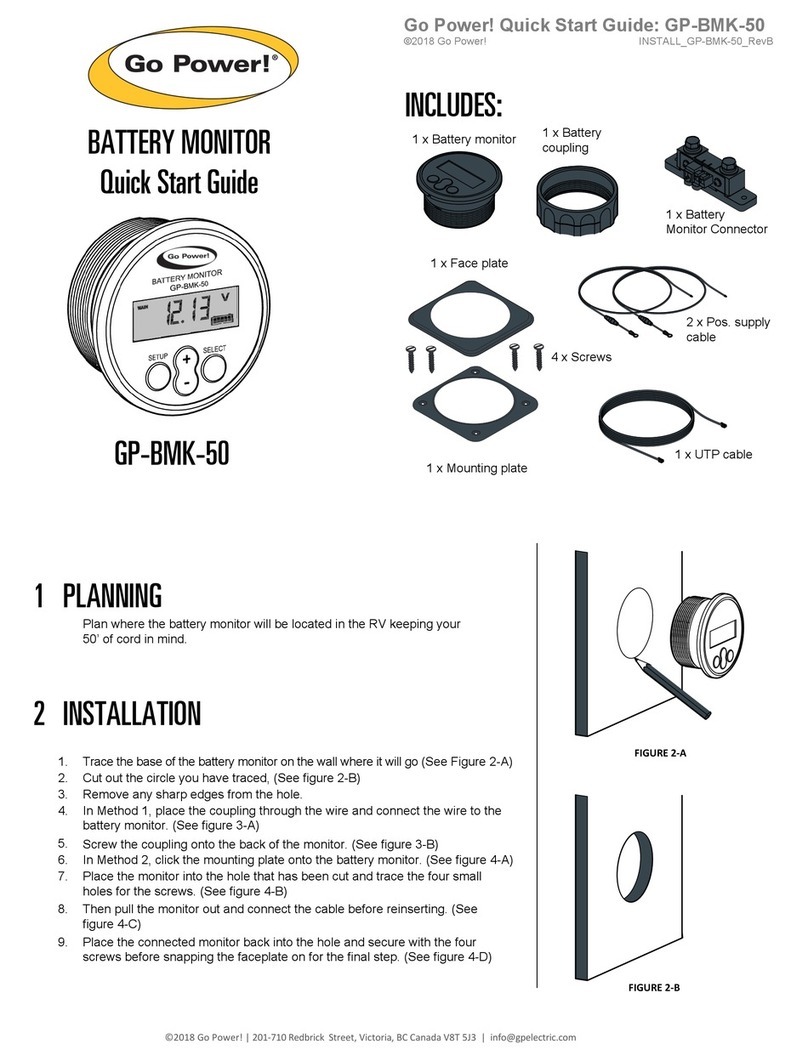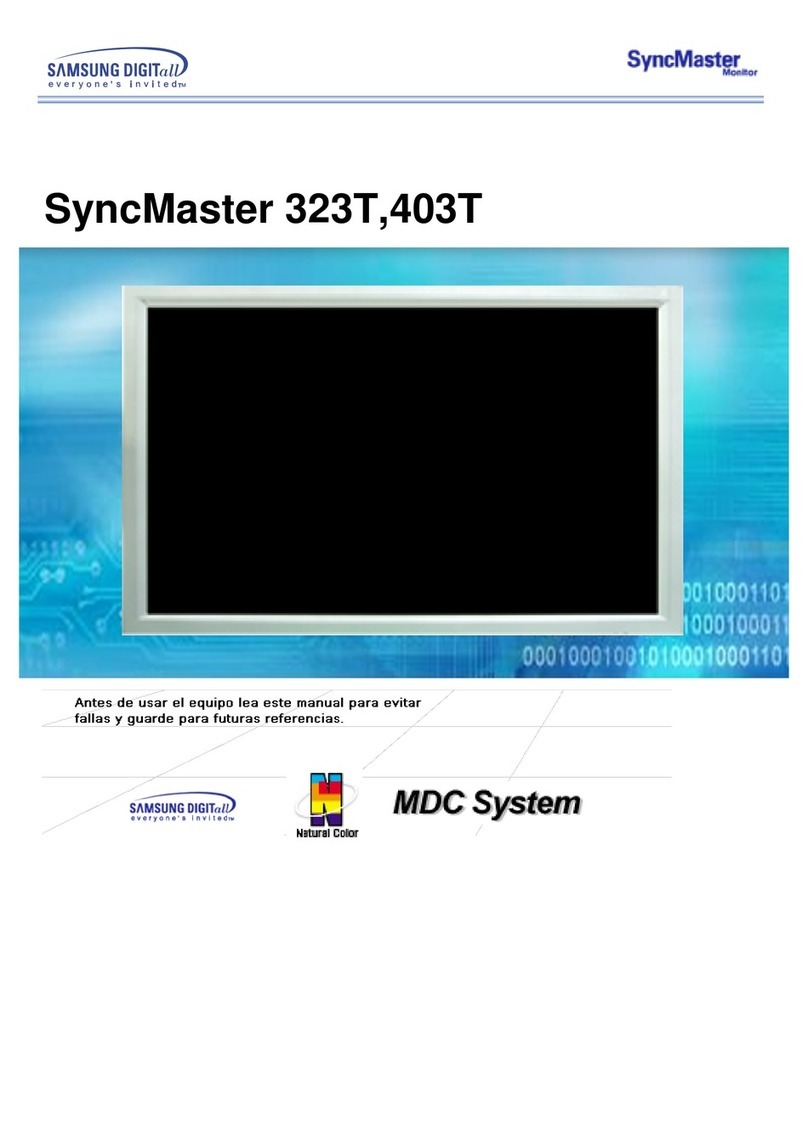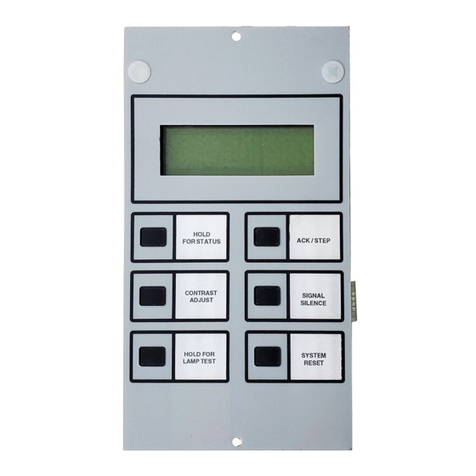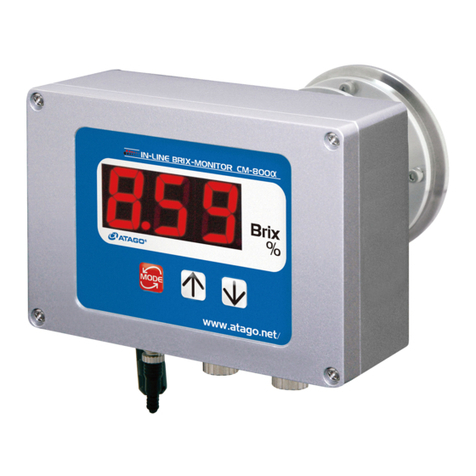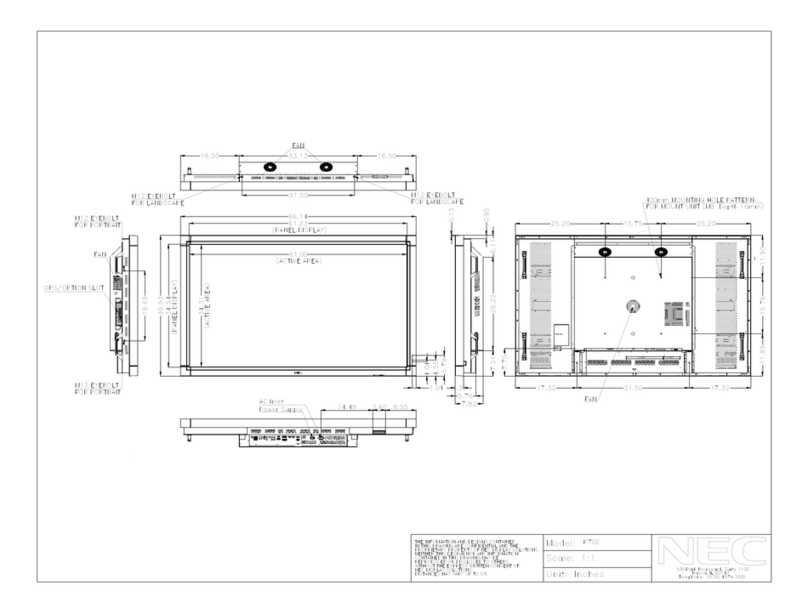Go Power GP-BMK-50 User manual

BATTERY MONITOR
GP-BMK-50
User Manual
© 2018 Go Power!®
Worldwide Technical Support and Product Information gpelectric.com
Go Power! Headquarters
201-710 Redbrick St, Victoria, BC Canada V8T 5J3
MAN_GP-BMK-50_RevE

[page 2] | gpelectric.com

gpelectric.com | [page 3]
1. CONTENTS
2. GETTING STARTED ............................................................................................................... 5
2.1 BATTERY CAPACITY ............................................................................................. 5
2.2 AUXILIARY INPUT (GP-BMK-50)........................................................................... 5
2.3 IMPORTANT COMBINED BUTTON FUNCTIONS ................................................. 6
3. NORMAL OPERATING MODE ............................................................................................... 7
3.1 READ OUT OVERVIEW ......................................................................................... 7
3.2 SYNCHRONIZING THE GP-BMK-50 ..................................................................... 8
3.3 COMMON PROBLEMS .......................................................................................... 9
4. FEATURES AND FUNCTIONALITY ..................................................................................... 10
4.1 WHY SHOULD I MONITOR MY BATTERY? ........................................................ 10
4.2 HOW DOES THE GP-BMK-50 WORK? ............................................................... 10
4.2.1 BATTERY CAPACITY AND RATE OF DISCHARGE .............................. 10
4.2.2 CHARGE EFFICIENCY (CEF).................................................................11
4.3 BATTERY STATE-OF-CHANGE DISPLAY OPTIONS...........................................11
4.4 HISTORY DATA .....................................................................................................11
4.5 USE OF ALTERNATIVE SHUNTS ........................................................................ 12
4.6 AUTOMATIC DETECTION OF NOMINAL SYSTEM VOLTAGE............................12
4.7 ALARM, BUZZER AND RELAY ............................................................................ 13
4.8 INTERFACE OPTIONS......................................................................................... 14
4.8.1 PC SOFTWARE...................................................................................... 14
4.8.2 LARGE DISPLAY AND REMOTE MONITORING................................... 14
4.8.3 CUSTOM INTEGRATION (PROGRAMMING REQUIRED).................... 14
4.9 ADDITIONAL FUNCTIONALITY OF THE GP-BMK-50......................................... 14
4.9.1 AUXILIARY BATTERY MONITORING .................................................... 15
4.9.2 BATTERY TEMPERATURE MONITORING............................................ 15
4.9.3 MIDPOINT VOLTAGE MONITORING..................................................... 15
5. FULL SET-UP DETAILS........................................................................................................ 16
5.1 USING THE MENUS............................................................................................. 16
5.2 FUNCTIONS OVERVIEW..................................................................................... 17
5.2.1 BATTERY SETTINGS............................................................................. 17
5.2.2 RELAY SETTINGS.................................................................................. 19
5.2.3 ALARM·BUZZER SETTINGS ................................................................. 22
5.2.4 DISPLAY SETTINGS .............................................................................. 24
5.2.5 MISCELLANEOUS ................................................................................. 25
5.3 HISTORY DATA .................................................................................................... 26
6. MORE ABOUT PEUKERT’S FORMULA & MIDPOINT MONITORING ............................... 28
6.1 PEUKERT’S FORMULA: BATTERY CAPACITY AND DISCHARGE RATE ......... 29
6.2 MIDPOINT VOLTAGE MONITORING................................................................... 29
6.2.1 HOW THE % MIDPOINT DEVIATION IS CALCULATED ....................... 30
6.2.2 SETTING THE ALARM LEVEL ............................................................... 30
6.2.3 ALARM·DELAY ....................................................................................... 30
6.2.4 WHAT TO DO IN CASE OF AN ALARM DURING CHARGING.............. 31
6.2.5 WHAT TO DO IN CASE OF AN ALARM DURING DISCHARGING........ 31
7. LITHIUM IRON PHOSPHATE BATTERIES (LiFeP04)......................................................... 32
8. DISPLAY................................................................................................................................ 33
9. TECHNICAL DATA................................................................................................................ 35

[page 4] | gpelectric.com
Safety Precautions
WARNING!
Personal Injury
Working in the vicinity of a lead acid battery is dangerous. Batteries can generate explosive
gases during operation. Never smoke or allow a spark or ame in the vicinity of a battery.
Provide sucient ventilation around the battery.
Wear eye and clothing protection. Avoid touching eyes while working near batteries. Wash
your hands when done.
If battery acid contacts skin or clothing, wash them immediately with soap and water. If acid
enters an eye, immediately ood the eye with running cold water for at least 15 minutes and
get medical attention immediately.
Be careful when using metal tools in the vicinity of batteries. Dropping a metal tool onto a
battery might cause a short circuit and possibly an explosion.
Ensure that children, pets, and other animals are kept away from the inverter, solar arrays,
battery bank, and utility grid components.
Remove personal metal items such as rings, bracelets, necklaces, and watches when working
with a battery. A battery can produce a short circuit current high enough to melt objects such
as rings, causing severe burns.

gpelectric.com | [page 5]
This manual assumes that the GP-BMK-50 is being installed for the rst time, or that factory settings have been
restored.
The GP-BMK-50 factory settings are suitable or all battery chemistries.
The GP-BMK-50 will automatically detect the nominal voltage of the battery system immediately after completion of
the set-up wizard (for details and limitations of automatic nominal voltage detection, see section 3.8). Therefore, the
only settings which need to be made are the battery capacity and the functionality of the auxiliary input.
Please install the GP-BMK-50 in accordance with the Quick Start Guide. After inserting the fuse in the positive
supply cable to the main battery, the GP-BMK-50 will automatically start the set-up wizard.
PLEASE NOTE:
a) In case of Li-ion batteries, several settings may have to be changed. Please refer to section 6. The set-up
wizard below must be completed before other settings can be made.
b) When using a shunt other than the one supplied with the GP-BMK-50, please refer to section 3.6. The set-up
wizard below must be completed before other settings can be made.
USING THE SET-UP WIZARD
2.1 SETTING BATTERY CAPACITY
a) After inserting the fuse, the display will show scrolling text.
If this text is not shown, press SETUP and SELECT simultaneously for a 3 second period to restore the factory
settings or go to section 4 for the full set-up details (setting 64, Lock set-up must be OFF to restore factory settings.
See section 4.2.5).
b) Press any button to stop scrolling and the factory default value Ah (total amp hours of battery bank) will appear
in the edit mode; the rst digit will blink.
Enter the desired value with the + and - buttons.
c) Press SETUP or + or - to proceed to auxiliary input setting.
2.2 USING AN AUXILIARY INPUT
a) The display will show (second battery) scrolling.
b) Press SELECT to stop scrolling and the LCD will show:
Use the + or - key to select the required function of the auxiliary input
for monitoring the starter battery voltage.
for monitoring the mid-point voltage of a battery bank.
for using the optional temperature sensor.
Press SELECT to conrm. Conrmation is indicated with a short beep.
c) Press SETUP or + or - to end the set-up wizard and switch to normal operating mode.
The GP-BMK-50 is now ready for use.
When powered up for the rst time, the GP-BMK-50 will display 100% state of change.
2. GETTING STARTED

[page 6] | gpelectric.com
GETTING STARTED
When in normal mode, the back-light of the GP-BMK-50 switches o after no key has been pressed for 60 seconds.
Press any key to restore the back-light. Go Power disclaims liability for any direct, indirect or incidental damages
caused by, or in case of, installation not performed following the instructions and cautions in this manual. Go Power
will refuse requests for exchanges or returns, resulting from the purchase and installation of items which do not
comply with local codes. To avoid such concerns Go Power recommends installation by a professional electrician,
RV or marine, or solar technician. Examples that are shown within this manual are for illustrative purposes only.
2.3 IMPORTANT COMBINED BUTTON FUNCTIONS
a) Restore factory settings
Press and hold SETUP and SELECT simultaneously for 3 seconds.
b) Manual synchronization
Press and hold the up and down buttons simultaneously for 3 seconds.
c) Silence audible alarm
An alarm is acknowledged when any button is pressed, however, the alarm icon is displayed as long as the alarm
condition remains.
GET REAL-TIME DATA DISPLAYED ON A SMART PHONE
With the GP-BTD (Go Power! Battery Monitor Dongle), real-time data and alarms can be
displayed on Apple and Android smart phones, tables and other devices.
You will need to download the free Go Power! ConnectTM app from Google Play or the Apple Store.

gpelectric.com | [page 7]
3. NORMAL OPERATING MODE
3.1 READ-OUT OVERVIEW
In normal operating mode, the GP-BMK-50 displays an overview of important parameters.
The + and - selection buttons give access to various read-outs.
BATTERY VOLTAGE:
AUXILIARY BATTERY VOLTAGE:
When the auxiliary input is set to START.
CURRENT:
The actual current owing out of the battery (negative
sign) or into the battery (positive sign).
POWER:
The power drawn from the battery (negative sign) or
owing into the battery (positive sign).
CONSUMED AMP-HOURS:
The amount of Ah consumed from the battery
Example:
If a current of 12A is drawn from a fully charged battery for a period of 3 hours, this readout will show -36.0Ah.
(-12 x 3 = -36)
STATE OF CHANGE:
A fully charged battery will be indicated by a value of 100.0%. A
fully discharged battery will be indicated by a value of 0.0%.
TIME TO GO:
An estimation of how long the battery can support the present load
until it needs recharging.
The time-to-go displayed is the time to reach the discharge oor. See 4.2.2, setting number 16.
BATTERY TEMPERATURE:
When the auxiliary input is set to TEMP.
The value can be displayed in degrees Celsius or degrees
Fahrenheit. See section 4.2.5

[page 8] | gpelectric.com
NORMAL OPERATING MODE
BATTERY BANK TOP SECTION VOLTAGE:
When the auxiliary input set to MID. Compare with the bottom
section voltage to check battery balancing. For more about battery
midpoint monitoring, see section 5.2.
BATTERY BANK BOTTOM SECTION VOLTAGE:
When the auxiliary input is set to MID. Compare with the top section
voltage to check battery balancing.
BATTERY BANK MID-POINT DEVIATION VOLTAGE:
When the auxiliary input is set to MID. Deviation in Volts of the
mid-point voltage.
3.2 SYNCHRONIZING THE GP-BMK-50
For a reliable readout, the state of charge as displayed by the battery monitor has to be synchronized regularly with
the true state of charge of the battery. This is accomplished by fully charging the battery.
In case of a 12V battery, the GP-BMK resets to ‘fully charged’ when the following ‘charged parameters’ are met: the
voltage exceeds 13.2V and simultaneously the (tail-) charge current is less than 4.0% of the total battery capacity
(e.g. 8A for a 200Ah battery) during 4 minutes.
The GP-BMK can also be synchronized (i.e. set to ‘battery fully charged’) manually if required. This can be achieved
in normal operating mode by holding the + and – buttons simultaneously for 3 seconds, or in setup mode by using
the SYNC option (see section 4.2.1, setting number 10).
If the GP-BMK does not synchronize automatically, the charged voltage, tail current, and/or charged time may need
adjustment.
When the voltage supply to the BMK has been interrupted, the battery monitor must be resynchronized before it
can operate correctly.
3.3 COMMON PROBLEMS
NO SIGNS OF LIFE ON THE DISPLAY
Probably the GP-BMK-50 is not properly wired. The UTP cable should be properly inserted at both ends, the shunts
must be connected to the minus pole of the battery and the positive supply cable should be connected to the plus
pole of the battery with the fuse inserted.
The temperature sensor (when used) must be connected to the positive pole of the battery bank (one of the two
wires for the sensor doubles as the power supply wire).
CHARGE AND DISCHARGE CURRENT ARE INVERTED
Charge current should be shown as a positive value. For example: +1.45A.
Discharge current should be shown as a negative value. For example: -1.45A.
If charge and discharge current are inverted, the power cables on the shunt must be swapped: see the quick
installation guide.

gpelectric.com | [page 9]
THE GP-BMK-50 DOES NOT SYNCHRONIZE AUTOMATICALLY
One possibility is that the battery never reaches the fully charged state. The other possibility is that the charged
voltage setting should be lowered and/or the tail current setting should be increased. See section 4.2.1.
THE GP-BMK-50 SYNCHRONIZES TOO EARLY
In solar systems or other applications with uctuating charge currents the charged voltage should be set only slightly
below the absorption charge voltage (for example: 14.1V in case of 14.4V absorption voltage). This will prevent the
GP-BMK-50 from switching prematurely to 100% state of charge.
SYNC AND BATTERY ICON ARE BLINKING
This means the battery is not synchronized. Charge the batteries and the GP-BMK-50 should sync automatically.
If that doesn’t work, review the sync settings, Or if you know the battery is fully charged but don’t want to wait until
the GP-BMK-50 synchronizes, press and hold the UP and DOWN button simultaneously until you hear a beep. See
section 4.2.1.
4.1 WHY SHOULD I MONITOR MY BATTERY?
Batteries are used in a wide variety of applications, mostly to store energy for later use. But how much energy is
stored in the battery? No one can tell just by looking at it.
The service life of batteries depends on many factors. Battery life may be shortened by under-charging, over-charging,
excessively deep discharges, excessive charge or discharge current and high ambient temperature. By monitoring
the battery with an advanced battery monitor, important feedback is given to the user so that remedial measures
can be taken when necessary. Doing this will extend battery liferesulting in the GP-BMK-50 quickly paying for itself.
4.2 HOW DOES THE GP-BMK-50 WORK?
The main function of the GP-BMK-50 is to follow and indicate the state of change of a battery, in particular to prevent
unexpected total discharge.
The GP-BMK-50 continuously measures the current ow in and out of the battery. Integration of this current over
time (which, if the current is a xed amount of Amps, boils down to multiplying current and time) gives the net amount
of Ah added or removed.
Example: discharge current of 10A during 2 hours will take 10 x 2 = 20Ah from the battery.
However, there are external components that negatively aect a battery capacities, such as rate of discharge, charge
eciency, and temperature.
4.2.1 BATTERY CAPACITY AND THE RATE OF DISCHARGE
The capacity of a battery is rated in ampere-hours (Ah). For example, a lead acid battery that can deliver a current
of 5A during 20 hours is rated at C20 = 100Ah (5 x 20 = 100).
When the same 100Ah battery is discharged completely in two hours, it may only give C2 = 56AH (because the
higher rate of discharge).
The GP-BMK-50 takes this phenomenon into account with Peukert’s formula. (See section 5.1).
4. FEATURES AND FUNCTIONALITY

[page 10] | gpelectric.com
4.2.2 CHARGE EFFICIENCY (CEF)
The charge eciency of a lead acid battery is almost 100% as long as no gas generation takes place. Gassing
means that part of the charge current is not transformed into chemical energy, which is stored in the plates of the
battery, but is used to decompose water into oxygen and hydrogen gas (highly explosive!). The Amp-hours stored
in the plates can be retrieved during the next discharge, whereas the Amp-hours used to decompose water are
lost. Gassing can easily be observed in ooded batteries. Please note that the oxygen only end of charge phase of
sealed (VRLA) gel and AGM batteries also results in a reduced charge eciency.
A charge eciency of 95% means that 10Ah must be transferred to the battery to get 9.5Ah actually stored in the
battery. The charge eciency of a battery depends on battery type, age and usage.
The GP-BMK-50 takes this phenomenon into account with the charge eciency factor. (See section 4.2.2, setting
number 06.
4.3 BATTERY STATE OF CHANGE DISPLAY OPTIONS
The GP-BMK-50 can display both the Amp-hours removed (consumed Amphours readout, compensated for charge
eciency only) and the actual state of charge in percent (state of charge readout, compensated for charge eciency
and Peukert eciency). Reading the state of charge is the best way to monitor the battery.
The GP-BMK-50 also estimates how long the battery can support the present load, the time to go readout. This
is the actual time left until the battery is discharged to the discharge oor. The factory setting is 50% (See 4.2.2,
setting number 16).
If the loads are uctuating heavily, it is best not to rely on this reading too much since it is a momentary readout
and must be used as a guideline only. We always encourage the use of the state of change readout for accurate
battery monitoring.
4.4 HISTORY DATA
The GP-BMK-50 stores events which can be used at a later date to evaluate usage patterns and battery health.
Select the history data menu by pressing ENTER when in normal mode (See section 4.3).
4.5 USE OF ALTERNATIVE SHUNTS
The GP-BMK-50 is supplied with a 500A/50mV shunt. For most applications, this should be suitable, however, the
GP-BMK-50 can be congured to work with a wide range of dierent shunts. Shunts of up to 9999A and/or 75mV
can be used.
When using a shunt other than the one supplied with the GP-BMK-50, please proceed as follows:
Unscrew the PCB from the supplied shunt.
Mount the PCB on the new shunt, ensuring that there is good electrical contact between the PCB and the shunt.
Connect the shunt and GP-BMK-50 as shown in the quick installation guide.
Follow the set-up wizard (Section 1.1 and 1.2).

gpelectric.com | [page 11]
After completion of the set-up wizard, set the proper shunt current and shunt voltage according to Section 4.2.5,
setting number 65 and 66.
If the GP-BMK-50 reads a non-zero current, even when there is no load and the battery is not being charged, calibrate
the zero current reading (see section 4.2.1, setting number 09).
4.6 AUTOMATIC DETECTION OF NOMINAL SYSTEM VOLTAGE
The GP-BMK-50 will automatically adjust itself to the nominal voltage of the battery bank, immediately after completion
of the set-up wizard.
The following table shows how the nominal voltage is determined and how the charged voltage parameter (see
section 2.2) is adjected as a result.
In case of another nominal battery bank voltage (32V for example), the Charged Voltage must be set manually
(see section 4.2.1, setting 02).
Recommended Settings
(Nominal Battery Voltage)
Recommended Charged
Voltage Setting
12V 13.2V
24V 26.4V
36V 39.6V
48V 52.8V
60V 66V
120V 132V
144V 158.4V
288V 316.8V
4.7 ALARM, BUZZER AND RELAY
On most of the GP-BMK-50’s readings, an alarm can be triggered when the value reaches a set threshold. When
the alarm becomes active the buzzer starts to beep, the back-light ashes and the alarm icon is visible in the display
along with the current value.
The corresponding segment will also ash. AUX when a starter alarm occurs. MAIN, MID or TEMP for the corresponding
alarm.
(When in the set-up menu and an alarm occurs, the value causing the alarm will not be visible.)
An alarm is acknowledged when a button is pressed. However, the alarm icon is displayed as long as the alarm
condition remains.
FEATURES AND FUNCTIONALITY
GP-BMK
GP-BMK-50

[page 12] | gpelectric.com
It is also possible to trigger the relay when an alarm condition occurs.
The relay contact is open when the coil is de-energized (NO contact) and will close when the relay is energized.
Factory default setting: the relay is controlled by the state of charge of the battery bank. The relay will be energized
when the state of charge decreases to less than 50% (the discharge oor) and will be de-energized when the battery
has been recharged to 90% state of charge. See section 4.2.2. The relay function can be inverted: de-energized
becomes energized and vice versa. See section 4.2.2.
When the relay is energized, the current drawn by the GP-BMK-50 will increase slightly (see technical data).
4.8 INTERFACE OPTIONS
4.8.1 CUSTOM INTEGRATION (PROGRAMMING REQUIRED)
The Bluetooth Dongle port can be used to read data and change settings. The Bluetooth Dongle protocol is simple
to implement.
Transmitting data to the GP-BMK-50 is not necessary for simple applications, the GP-BMK-50 automatically sends
all readings every second. All the details are explained in this document. Visit gpelectric.com/go-power-connect for
more information
4.9 ADDITIONAL FUNCTIONALITY OF THE GP-BMK-50
In addition to the comprehensive monitoring of the main battery system, the GP-BMK-50 provides a second monitoring
input. This secondary input has three congurable options, described below.
4.9.1 AUXILIARY BATTERY MONITORING
Wiring diagram: see the quick installation guide. Fig 3
This conguration provides basic monitoring of a second battery, displaying its voltage. This is useful for systems
with a separate starter battery.
4.9.2 BATTERY TEMPERATURE MONITORING
Wiring diagram: see the quick installation guide. Fig 4
This temperature sensor is not interchangeable with other temperature sensors, as provided with battery chargers.
The temperature sensor must be connected to the positive pole of the battery bank (one of the two wires of the sensor
doubles as the power supply wire). The temperature can be displayed in degrees Celsius or degrees Fahrenheit,
see section 4.2.5, setting number 67.
The temperature measurement can also be used to adjust battery capacity to temperature, see section 4.2.5, setting
number 68.
The available battery capacity decreases with temperature. Typically, the reduction, compared to the capacity at
20°C, is 18% at O°C and 40% at -20°C.
FEATURES AND FUNCTIONALITY

gpelectric.com | [page 13]
4.9.3 MIDPOINT VOLTAGE MONITORING
Wiring diagram: see the quick installation guide. Fig 5 - 12
One bad cell or one bad battery can destroy a large, expensive battery bank. A short circuit or high internal leakage
current in one cell for example will result in under charge of that cell and over charge of the other cells.
Similarly, one bad battery in a 24Vor 48V bank of several series/parallel connected 12V batteries can destroy the
whole bank.
Moreover, when cells or batteries are connected in series, they should all have the same initial state-of-charge. Small
dierences will be ironed out during absorption or equalize charging, but large dierences will result in damage during
charging due to excessive gassing of the cells or batteries with the highest initial state-of-charge.
A timely alarm can be generated by monitoring the midpoint of the battery bank. For more information, see section 5.1.
5.1 USING THE MENUS
Four buttons control the GP-BMK-50. The function of the buttons depends on which mode the GP-BMK-50 is in.
5. FULL SET-UP DETAILS

[page 14] | gpelectric.com
When power is applied for the rst time or when factory settings have been restored, the GP-BMK-50 will start the
set-up wizard (see section 2). Thereafter, if power is applied, the GP-BMK-50 will start in normal mode (see section 3).
5.2 FUNCTIONS OVERVIEW
The following summary describes all the parameters of the GP-BMK-50.
- Press SETUP for two seconds to access these functions and use the + and - buttons to browse them.
- Press SELECT to access the desired parameter.
- Use SELECT and the + an - buttons to customize. A short beep conrms the setting.
- Press SETUP at any time to return to the scrolling text and press again to return to normal mode.
5.2.1 BATTERY SETTINGS
01. Battery Capacity
Battery capacity in Amp hours.
Default Range Step size
200Ah 1-9999Ah 1Ah
02. Charged Voltage
The battery voltage must be above this voltage level to consider the battery as fully charged. The charged-voltage-
parameter should always be slightly below the end of charge voltage of the charger (usually 0.2V or 0.3V below the
oat voltage of the charger). See section 3.7 for recommended settings.
GP-BMK-50
Default Range Step Size
See table, sec 3.7 0-95V 0.1V
03. Tail Current
Once the charge current has dropped to less than the set tail current (expressed as percentage of the battery
capacity), the battery is considered as fully charged.
Remark:
Some battery chargers stop charging when the current drops below a set threshold. The tail current must be set
higher than this threshold.
Default Range Step Size
4% 0.5-10% 0.1%
04. Charged Detection Time
This is the time the charged-parameters (Charged Voltage and Tail Current) must be met in order to consider the
battery fully charged..
Default Range Step size
3 minutes 1-50 minutes 1 minute
FULL SET-UP DETAILS

gpelectric.com | [page 15]
05. Peukert Exponent
When unknown, it is recommended to keep this value at 1.25 for lead acid batteries and 1.05 Li-ion batteries. A value
of 1.00 disables the Peukert compensation.
Default Range Step Size
1.25 1-1.5 0.01
06. Charge Eciency Factor
The Charge Eciency Factor compensates for the Ah losses during charging. 100% means no loss.
Default Range Step Size
95% 50-100% 1%
07. Current Threshold
When the measured current falls below this value, it will be considered zero. The current threshold is used to cancel
out very small currents that can negatively aect the long term state of charge readout in noisy environments.
For example, if the actual long term current is 0.0A and, due to injected noise or small osets, the battery monitor
measures 0.05A, and in the long term the BP-BMK-50 can incorrectly indicate that the battery needs recharging.
When the current threshold in this example is set to 0.1A, the GP-BMK-50 calculates with 0.0A so that errors are
eliminated. A value of 0.0A disables this function.
Default Range Step size
0.1A 0-2A 0.01A
08. Time to Go Averaging Period
Species the time window (in minutes) that the moving averaging lter works. A value of 0 disables the lter and gives
an instantaneous (real-time) readout, however, the displayed value may uctuate heavily. Selecting the longest time
(12 minutes) ensures that only long-term load uctuations are included in the time to go calculations.
Default Range Step Size
3 minutes 0-12 minutes 1 minute
09. Zero Current Calibration
If the GP-BMK-50 reads a non-zero current even when there is no load and the battery is not being charged, this
option can be used to calibrate the zero reading. Ensure that there really is no current owing into or out of the
battery (disconnect the cable between the load and the shunt), then press SELECT.
10. Synchronize
This option can be used to manually synchronize the GP-BMK-50. Press SELECT to synchronize. The GP-BMK-50
can also be synchronized when in normal operating mode by holding the + and - buttons simultaneously for 3 seconds.
FULL SET-UP DETAILS

[page 16] | gpelectric.com
5.2.2 RELAY SETTINGS
Remark: thresholds are disabled when set at 0.
11. Relay Mode
DFLT Default mode. The relay thresholds Nos. 16 up to 31 can be used to control the relay. CHRG Charger mode.
The relay will close when the state of charge falls below setting 16 (discharge oor) or when the battery voltage
falls below setting 18 (low voltage relay). The relay will be open when the state of voltage is higher than setting 17
(clear state of charge relay) and the battery voltage is higher than setting 19 (clear low voltage relay). Application
example: start and stop control of a generator, together with settings 14 and 15.
12. Invert Relay
This function enables selection between a normally de-energized (connect open) or a normally energized (contact
closed) relay. When inverted, the open and closed conditions as described in setting 11 (DFLT and CHRG), and
settings 14 up to 31 inverted. The normally energized setting will slightly increase supply current in the normal
operating mode.
Default Range
OFF: Normally de-energized OFF: Normally de-energized/ON: normally energized
13. Relay State (Read Only)
Displays whether the relay is open or closed (de-energized or energized).
Range
OPEN/CLOSED
14. Relay Minimum Closed Time
Sets the minimum amount of time that the CLOSED condition will remain present after the relay has been energized
(changes to OPEN and de-energized if the relay function has been inverted). Application example: set a minimum
generator run time (relay in CHRG mode).
15. Relay-o Delay
Sets the amount of time the de-energize relay condition must be present before the relay opens. Application example:
keep a genereator running for a while to better charge the battery (relay in CHRG mode).
Default Range Step Size
0 minutes 0-500 minutes 1 minute
16. SOC Relay (Discharge Floor)
When the state-of-charge percentage has fallen below this value, the relay will close. The time-to-go displayed is
the time to reach the discharge oor.
Default Range Step size
50% 0-99% 1%
FULL SET-UP DETAILS

gpelectric.com | [page 17]
17. Clear SOC Relay
When the state-of-charge percentage has risen above this value, the relay will open (after a delay, depending on
setting 14 and/or 15). This value needs to be greater than the previous parameter setting. When the value is equal
to the previous parameter the state-of-charge percentage will not close the relay.
Default Range Step Size
90% 0-99% 1%
18. Low Voltage Relay
When the battery voltage falls below this value for more than 10 seconds the relay will close.
19. Clear Low Voltage Relay
When the battery voltage rises above this value, the relay will open (after a delay,depending on setting 14 and/or
15). This value needs to be greater than or equal to the previous parameter.
20. High Voltage Relay
When the battery voltage rises above this value for more than 10 seconds the relay will close.
21. Clear High Voltage Relay
When the battery voltage falls below this value, the relay will open (after a delay, depending on setting 14 and/or
15). This value needs to be less than or equal to the previous parameter.
GP-BMK-50
Default Range Step Size
0V 0-95V 0.1V
22. Low Starter Voltage Relay
When the auxiliary (e.g. starter battery) voltage falls below this value for more than 10 seconds the relay will be
activated.
23. Clear Low Starter Voltage Relay
When the auxiliary voltage rises above this value, the relay will open (after a delay,depending on setting 14 and/or
15). This value needs to be greater than or equal to the previous parameter.
24. Higher Starter Voltage Relay
When the auxiliary (e.g. starter battery) voltage rises above this value for more than 10 seconds, the relay will be
activated.
FULL SET-UP DETAILS

[page 18] | gpelectric.com
25. Clear High Starter Voltage Relay
When the auxiliary voltage falls below this value, the relay will open (after a delay, depending on setting 14 and/or
15). This value needs to be less than or equal to the previous parameter.
Default Range Step Size
0V 0-95V 0.1V
26. High Temperature Relay
When the battery temperature rises above this value for more than 10 seconds, the relay will be activated.
27. Clear High Temperature Relay
When the temperature falls below this value, the relay will open (after a delay, depending on setting 14 and/or 15).
This value needs to be less than or equal to the previous parameter.
28. Low Temperature Relay
When the temperature falls below this value for more than 10 seconds, the relay will be activated.
29. Clear Low Temperature Relay
When the temperature rises above this value, the relay will open (after a delay, depending on setting 14 and/or 15).
This value needs to be greater than or equal to the previous parameter. See setting 67 for choosing between °C
and °F.
Default Range Step Size
0°C -99 - 99°C 1°C
0°F -146 - 210°F 1°F
30. Mid Voltage Relay
When the mid-point voltage deviation rises above this value for more than 10 seconds, the relay will be activated.
See section 5.2 for more information about the mid-point voltage.
31. Clear Mid Temperature Relay
When the mid-point voltage deviation falls below this value, the relay will open (after a delay, depending on setting
14 and/or 15). This value needs to be less than or equal to the previous parameter.
Default Range Step Size
0% 0-99% 0.1%
FULL SET-UP DETAILS

gpelectric.com | [page 19]
5.2.3 ALARM BUZZER SETTINGS
Remark: thresholds are disabled when set at 0.
32. Alarm Buzzer
When set, the buzzer will sound an alarm. After a button is pressed the buzzer will stop sounding. When disabled
the buzzer will not sound an alarm.
Default Range
ON ON/OFF
33. Low SOC Alarm
When the state-of-charge falls below this value for more than 10 seconds the low SOC alarm is turned on. This is
a visual and audible alarm. It does not energize the relay.
34. Clear Low SOC Alarm
When the state-of-charge rises above this value, the alarm is turned o. This value needs to be greater than or
equal to the previous parameter.
Default Range Step Size
0% 0-99% 1%
35. Low Voltage Alarm
When the battery voltage falls below this value for more than 10 seconds the low voltage alarm is turned on. This
is a visual and audible alarm. It does not energize the relay.
36. Clear Low Voltage Alarm
When the battery voltage rises above this value, the alarm is turned o. This value needs to be greater than or equal
to the previous parameter.
37. Low Voltage Alarm
When the battery voltage rises above this value for more than 10 seconds the, low voltage alarm is turned on. This
is a visual and audible alarm. It does not energize the relay.
38. Clear High Voltage Alarm
When the battery voltage falls below this value, the alarm is turned o. This value needs to be less than or equal to
the previous parameter.
GP-BMK-50
Default Range Step Size
0V 0-95V 0.1V
39. Low Starter Voltage Alarm
When the auxiliary (e.g. starter battery) voltage falls below this value for more than 10 seconds the alarm will be
activated. This is a visual and audible alarm. It does not energize the relay.
FULL SET-UP DETAILS

[page 20] | gpelectric.com
40. Clear Low Starter Voltage Alarm
When the auxiliary voltage rises above this value, the alarm is switched o. This value needs to be greater than or
equal to the previous parameter.
41. High Starter Voltage Alarm
When the auxiliary (e.g. starter battery) voltage rises above this value for more than 10 seconds, the alarm will be
activated. This is a visual and audible alarm. It does not energize the relay.
42. Clear High Starter Voltage Alarm
When the auxiliary voltage falls below this value, the alarm is switched o. This value needs to be less than or equal
to the previous parameter.
Default Range Step Size
OV 0-95V 0.1 V
43. High Temperature Alarm
When the battery temperature rises above this value for more than 10 seconds, the alarm will be activated. This is
a visual and audible alarm. It does not energize the relay.
44. Clear High Temperature Alarm
When the temperature falls below this value, the alarm is switched o. This value needs to be less than or equal to
the previous parameter.
45. Low Temperature Alarm
When the temperature falls below this value for more than 10 seconds, the alarm will be activated. This is a visual
and audible alarm. It does not energize the relay.
46. Clear Low Temperature Alarm
When the temperature rises above this value, the alarm is switched o. This value needs to be greater than or equal
to the previous parameter. See parameter 67 for choosing between °C and °F.
Default Range Step Size
0°C -99 - 99°C 1°C
0°F -146 - 210°F 1°F
47. Mid Voltage Alarm
When the mid-point voltage deviation rises above this value for more than 10 seconds, the alarm will be activated.
This is a visual and audible alarm. It does not energize the relay. See section 5.2 for more information about midpoint
voltage.
Default Range Step Size
2% 0-99% 0.1%
FULL SET-UP DETAILS
Other manuals for GP-BMK-50
3
Table of contents
Other Go Power Monitor manuals
